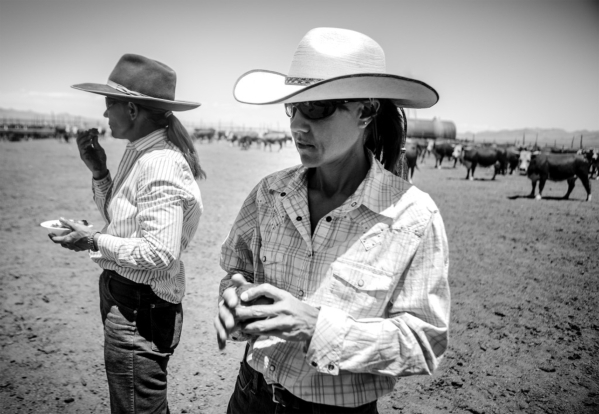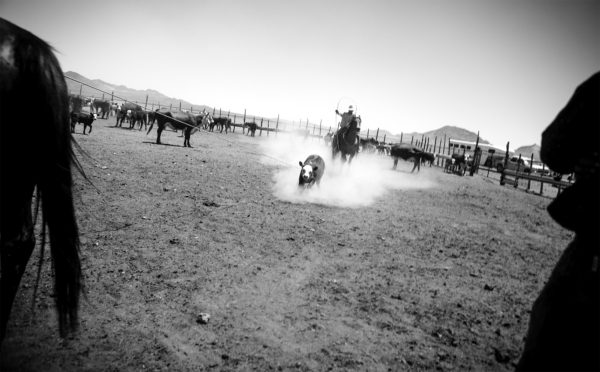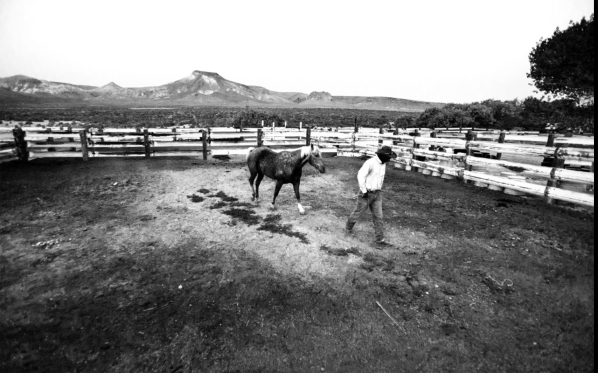RJ photographer’s exhibit focuses on Nevada ranching family






















For 34 years at the Review-Journal, photojournalist Jeff Scheid’s camera has captured everyone from mobsters to showgirls.
In his first solo photography exhibit, however, Scheid shifts angles — away from Las Vegas and toward a rural Nevada family that’s been around as long as Nevada itself.
Scheid’s “Ranching in the High Desert: Five Generations, One Family” opens a yearlong run at the Nevada State Museum in Carson City with a free 5 p.m. reception Thursday.
The exhibit offers a close-up view of life at Twin Springs Ranch in Nye County.
That’s where Scheid and reporter Jennifer Robison visited last year for the Review-Journal’s Nevada 150 sesquicentennial project, which focused on various aspects of Silver State history.
The exhibit’s 28 black-and-white images — about half of them 36-inch-wide enlargements — depict ranch life during branding season; Robison contributes the text accompanying the photos.
The exhibit begins “with a cowboy with a horse in the corral, when the sun’s coming up,” Scheid says, and follows a day in the life at the Twin Springs roundup.
The large-format photos enable museumgoers to “almost smell the smoke and feel the dust on your body,” Scheid says.
In addition to shots of rounding up and branding cattle, Scheid also captures more intimate moments: a wrangler sitting at a water trough, a 6-year-old hugging a horse.
That 6-year-old, now 7, is Giovanni Berg, whose great-great-grandfather, Giovanni Fallini, started the ranch that his parents, grandparents, sister, aunt and cousins now work.
Sometimes, Giovanni’s mom, Anna Fallini, jokingly admits she curses the family patriarch for settling in such rugged country: 50 miles east of Tonopah, where the family runs 1,800 to 2,500 head of cattle across more than a thousand square miles.
When Scheid first visited the Fallini ranch — to shoot photographs for an article about home schooling — he “was in awe seeing the Fallini family photos,” which he describes as “history on the walls, all in black-and-white.”
The Fallini family’s obvious pride in its history prompted Scheid to think, ” ‘I want to do this story.’ “
After more than a month of entreaties, Scheid persuaded the family to allow the Review-Journal to document its home on the range.
In the spirit of the family photographs he’d seen, Scheid opted to shoot his images in black-and-white, in part to “show the detail and starkness” of the subject matter.
Shooting in black-and-white also enabled him to convey the timelessness of life at Twin Springs, he adds.
“There are only two photos that have anything that says ‘modern,’ ” Scheid says. “You could almost think they were taken 150 years ago.”
Scheid’s affinity for ranch life comes naturally. While in high school, the Montana native worked as a ranch hand himself, feeding and branding cattle, mending fences, stacking hay.
Observing the Twin Springs roundup, “what you see out there is like theater,” Scheid says, where — despite behind-the-scenes “chaos” — “it all comes together. Everyone smiles. They’re having fun.”
It may be fun, but “this lifestyle needs to be a choice,” Fallini acknowledges, because it can be “a difficult life.”
Yet the Air Force veteran, who’s “been all around the world,” still hasn’t “seen a place as beautiful” as the Nevada landscape she calls home, she reflects. “You have to understand it.”
Helping others understand Nevada’s ranching traditions — and other aspects of Silver State history — remains a priority for Scheid.
“Our state is changing so much now,” he says. “Going through Nevada from point A to point B at 75 miles an hour, you wonder who lives there.”
In the case of the Fallinis, “they have this amazing story — in this case, five generations,” he says. “It’s still there from 150 years ago. It gives me chills.”
For more stories from Carol Cling go to bestoflasvegas.com. Contact her at ccling@reviewjournal.com and follow @CarolSCling on Twitter.
Preview
What: “Ranching in the High Desert: Five Generations, One Family”
When: 8:30 a.m. to 4:30 p.m. Tuesdays through Sundays, through August 2016 (opening reception 5 p.m. Thursday)
Where: Nevada State Museum, 600 N. Carson St., Carson City
Tickets: $8 for adults, free for museum members and ages 17 and younger (775-687-4810)


















